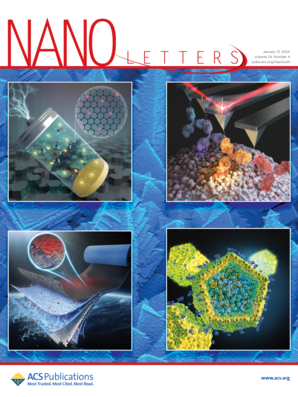同时调控CsSnI3钙钛矿的结晶和抑制氧化实现高效稳定的近红外发光二极管
IF 9.6
1区 材料科学
Q1 CHEMISTRY, MULTIDISCIPLINARY
引用次数: 0
摘要
在900 nm以上的近红外波段发光的锡基卤化物钙钛矿发光二极管(PeLEDs)在夜视、生物医学和通信领域具有巨大的应用潜力。然而,锡基钙钛矿中Sn2+的快速结晶和氧化对实现高性能稳定的ped构成了重大挑战。在这里,我们报道了一种高效的全无机cssni3基PeLED,通过使用多功能橙皮苷添加剂来调节钙钛矿薄膜的结晶动力学和抑制氧化过程。橙皮苷在氧原子旁边具有羟基,提供孤电子对,分别与I -形成氢键,与Sn2+形成强配位,减缓了CsSnI3的结晶速度,形成了高覆盖密度的薄膜。重要的是,橙皮苷与Sn2+的配位保护了钙钛矿膜免受Sn2+到sn4 +的氧化。最后,我们展示了高效稳定的pled,其峰值为948 nm,外量子效率为4.7%,半衰期超过11小时。本文章由计算机程序翻译,如有差异,请以英文原文为准。

Simultaneous Regulation of Crystallization and Suppression of Oxidation in CsSnI3 Perovskite Enables Efficient and Stable Near-Infrared Light-Emitting Diodes
Tin-based halide perovskite light-emitting diodes (PeLEDs) emitting in the near-infrared region beyond 900 nm hold tremendous potential for applications in night vision, biomedicine, and communications. However, rapid crystallization and oxidation of Sn2+ in tin-based perovskites pose significant challenges for achieving stable PeLEDs with high performance. Here, we report an efficient all-inorganic CsSnI3-based PeLED by employing a multifunctional hesperetin additive to modulate the crystallization kinetics and inhibit the oxidation process of the perovskite films. Hesperetin possesses hydroxyl groups alongside oxygen atoms offering lone electron pairs, which form hydrogen bonds with I– and strongly coordinate with Sn2+, respectively, slowing down crystallization of CsSnI3 and resulting in high coverage density films. Importantly, the coordination of hesperetin with Sn2+ protects the perovskite films from Sn2+-to-Sn4+ oxidation. Finally, we demonstrate efficient and stable PeLEDs with a peak at 948 nm, an external quantum efficiency of 4.7%, and a half-lifetime of over 11 h.
求助全文
通过发布文献求助,成功后即可免费获取论文全文。
去求助
来源期刊

Nano Letters
工程技术-材料科学:综合
CiteScore
16.80
自引率
2.80%
发文量
1182
审稿时长
1.4 months
期刊介绍:
Nano Letters serves as a dynamic platform for promptly disseminating original results in fundamental, applied, and emerging research across all facets of nanoscience and nanotechnology. A pivotal criterion for inclusion within Nano Letters is the convergence of at least two different areas or disciplines, ensuring a rich interdisciplinary scope. The journal is dedicated to fostering exploration in diverse areas, including:
- Experimental and theoretical findings on physical, chemical, and biological phenomena at the nanoscale
- Synthesis, characterization, and processing of organic, inorganic, polymer, and hybrid nanomaterials through physical, chemical, and biological methodologies
- Modeling and simulation of synthetic, assembly, and interaction processes
- Realization of integrated nanostructures and nano-engineered devices exhibiting advanced performance
- Applications of nanoscale materials in living and environmental systems
Nano Letters is committed to advancing and showcasing groundbreaking research that intersects various domains, fostering innovation and collaboration in the ever-evolving field of nanoscience and nanotechnology.
 求助内容:
求助内容: 应助结果提醒方式:
应助结果提醒方式:


